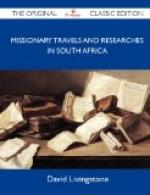Vast shoals of fish come down the Leeambye with the rising waters, as we observed they also do in the Zouga. They are probably induced to make this migration by the increased rapidity of the current dislodging them from their old pasture-grounds higher up the river. Insects constitute but a small portion of the food of many fish. Fine vegetable matter, like slender mosses, growing on the bottom, is devoured greedily; and as the fishes are dislodged from the main stream by the force of the current, and find abundant pasture on the flooded plains, the whole community becomes disturbed and wanders.
The mosala (’Clarias Capensis’ and ’Glanis siluris’), the mullet (’Mugil Africanus’), and other fishes, spread over the Barotse valley in such numbers that when the waters retire all the people are employed in cutting them up and drying them in the sun. The supply exceeds the demand, and the land in numerous places is said to emit a most offensive smell. Wherever you see the Zambesi in the centre of the country, it is remarkable for the abundance of animal life in and upon its waters, and on the adjacent banks.
We passed great numbers of hippopotami. They are very numerous in the parts of the river where they are never hunted. The males appear of a dark color, the females of yellowish brown. There is not such a complete separation of the sexes among them as among elephants. They spend most of their time in the water, lolling about in a listless, dreamy manner. When they come out of the river by night, they crop off the soft succulent grasses very neatly. When they blow, they puff up the water about three feet high.
Chapter 15.
Message to Masiko, the Barotse Chief, regarding the Captives— Navigation of the Leeambye—Capabilities of this District—The Leeba—Flowers and Bees—Buffalo-hunt—Field for a Botanist—Young Alligators; their savage Nature—Suspicion of the Balonda—Sekelenke’s Present—A Man and his two Wives—Hunters—Message from Manenko, a female Chief—Mambari Traders—A Dream—Sheakondo and his People—Teeth-filing—Desire for Butter—Interview with Nyamoana, another female Chief—Court Etiquette—Hair versus Wool—Increase of Superstition—Arrival of Manenko; her Appearance and Husband—Mode of Salutation—Anklets—Embassy, with a Present from Masiko—Roast Beef—Manioc—Magic Lantern—Manenko an accomplished Scold: compels us to wait—Unsuccessful Zebra-hunt.
On the 27th of December we were at the confluence of the Leeba and Leeambye (lat. 14d 10’ 52” S., long. 23d 35’ 40” E.). Masiko, the Barotse chief, for whom we had some captives, lived nearly due east of this point. They were two little boys, a little girl, a young man, and two middle-aged women. One of these was a member of a Babimpe tribe, who knock out both upper and lower front teeth as a distinction. As we had been informed by the captives on the previous Sunday that




